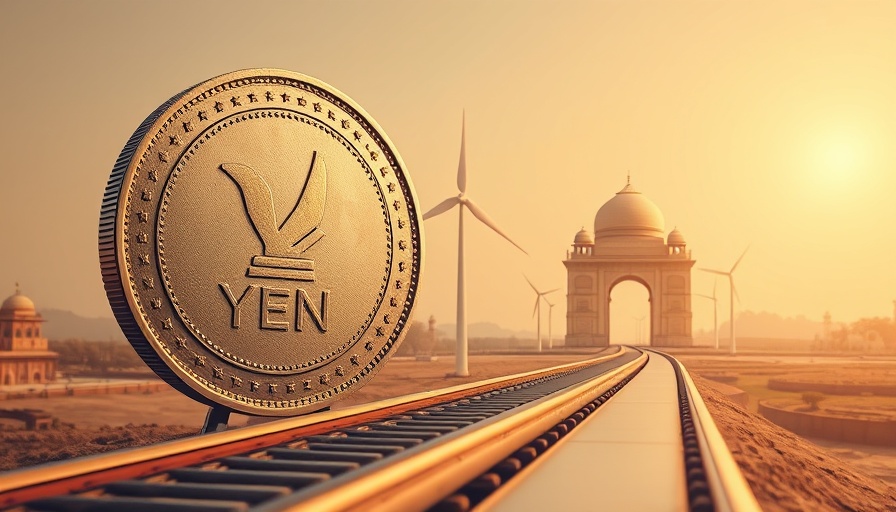
Japan's Strategic Gamble: A Closer Look at the ¥10 Trillion Investment
As the world shifts towards more resilient supply chains and clean energy solutions, Japan's recent announcement of a ¥10 trillion (≈ USD 68 billion) investment in India unveils serious implications for the global economic landscape. This ambitious step, articulated during Indian Prime Minister Narendra Modi's recent visit to Tokyo, marks a crucial leap from Japan's former commitment of ¥5 trillion in 2022. It aims to anchor India into Japan's long-term economic and security framework.
A New Era in Bilateral Relations
The backdrop of Tokyo's investment comes during a time when geopolitical dynamics are at play, particularly in the Indo-Pacific region. The nearly 100 Memorandums of Understanding (MoUs) signed between Indian and Japanese businesses highlight a critical pivot in how nations are reshaping their partnerships. Samuel Hertz, Head of APAC at EBC Financial Group, emphasizes that Japan's heightened investment isn't merely fiscal but a strategic maneuver against economic volatility and for reliable partnership, particularly concerning supply chains and climate technology.
Impact on Global Supply Chains
Japan's commitment could act as a counterweight to recent trade restrictions affecting Indian exports to the U.S., notably following the imposition of new tariffs. This investment isn’t just beneficial for India; it positions Japan as a significant stakeholder in stabilizing trade flows across Asia. With a promise to bolster its semiconductor, clean energy, AI-led innovation, and pharmaceuticals sectors, the investment is designed to construct a more robust trade ecosystem that mitigates global trade bending.
The Green Energy Transition: Japan's Commitment
One of the striking aspects of this initiative is its emphasis on clean energy. By engaging in a Clean Energy Dialogue focusing on hydrogen and renewable energy, Japan appears committed to not only fostering economic bonds but also aligning its investments with climate responsibility. This could usher in an augmented demand cycle for vital commodities such as lithium and rare earth elements, which are essential for the green transition.
Infrastructure Development: The Cultural and Human Dimension
The impact of Japan’s investment extends into infrastructure as well. Plans to introduce E10 Shinkansen bullet trains on critical routes like the Mumbai-Ahmedabad corridor signal a transformative phase in India's transport capabilities. Beyond infrastructural benefits, the initiative pledges pathways for 50,000 Indian professionals to work in Japan, thus fostering not only economic ties but cultural exchanges and understanding.
Shaping Future Dynamics in Education and Labor
India's involvement in Japan's advancements offers a dual benefit: enhanced productivity in Japanese industries and improved skillsets for Indian professionals. Analysts predict the cultural and financial ties created will yield significant capital inflows and aid in reducing existing economic disparities. This “human capital” exchange could be fundamental in integrating the yen-rupee trade corridor into a more vibrant economic matrix.
Looking Ahead: Will Capital Convergence Lead to Stability?
The long-term ramifications of Japan's ¥10 trillion investment could reshape not just the economic relationship between Japan and India but also signify an overarching reconfiguration of global value chains. EBC’s insights suggest that the convergence of capital, technology, and sustainability in India can pave a path toward resilience in a time characterized by uncertainty. Ultimately, India's ability to evolve into a manufacturing and technological powerhouse may rely heavily on Japan's investment foresight.
Conclusion: The Potential for Overhaul in Global Relations
As these developments unravel, the emphasis lies not just on economic growth but on empowering nations to thrive in a rapidly changing global landscape. Such strategic partnerships can foster deeper integration within the global economy—from increased trade flows to improved worker capabilities. Keeping abreast of these developments can arm professionals with insights that shape their business strategies in the context of international relations.
By understanding these dynamics, stakeholders should actively engage and seek opportunities that arise from this unfolding partnership.
 Add Row
Add Row  Add
Add 




Write A Comment